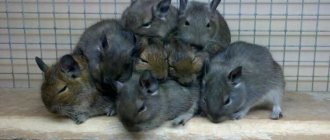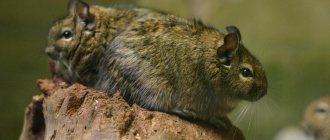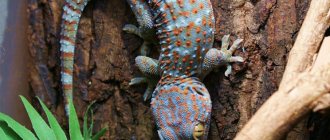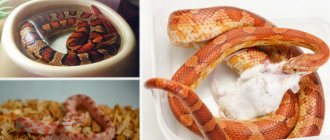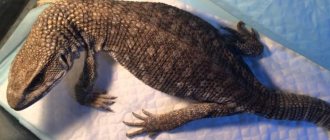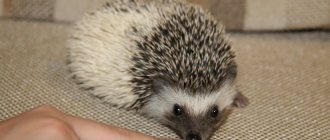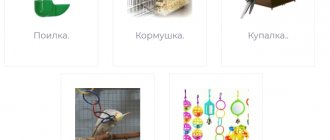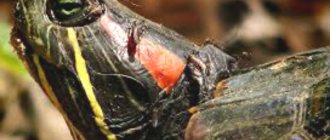The degu is a rodent native to South America. The animal is very active and friendly, has soft short fur, which is why it is loved by many people. He takes root well at home and quickly gets used to people. If you decide to get such a pet, information about it and our advice will definitely come in handy.
On a note! Degus are also called Chilean and bush squirrels.
Description
Degus, also called “degus”, look like small animals of the rodent order, but you shouldn’t immediately think that they are rats. They live in Chile and Peru, are found in Australia, and settle high in the mountains, for which they received the name “mountain squirrels,” although in appearance they look more like a jerboa.
They are also called Australian, Mexican and Chilean squirrels.
Appearance
Degus have a body from 10 to 15 cm long, a tail with a tassel at the end, which can reach a length of up to 12 cm, short, stiff gray-brown hair, and long hind legs. They do not have claws on their front paws in the usual sense; they rather resemble a nail plate. Small round ears are located on the wedge-shaped head. Long and movable whiskers serve for orientation in space. The eyes are wide-set and dark in color.
They are rodents, so they have pronounced incisors. Narrow jaws and constantly growing chewing teeth require roughage in the diet.
Character, habits, behavior
In the wild, degus live in packs of about seventy individuals. The pack is led by several females.
The degu squirrel does not show aggression either towards its fellows or towards humans. But they are difficult to tame and are not easy to handle, so you shouldn’t expect great love from them, although there are those who enjoy communicating with people. It all depends on your patience. If you show enough tact and do not frighten the squirrel with excessive importunity, it will quickly get used to your presence. Well, in principle, they are very funny to watch.
Degus prefer to live in burrows and very carefully decorate their home, using available means, most often dry grass and leaves. It is best to buy the animal bedding made of special synthetic padding so that it does not build a nest from food scraps. Straw and hay are not suitable; degus cannot tolerate dust and may even get sick.
Degus feed mainly on grass and seeds; you can also feed them the bark of trees and shrubs.
The Mexican squirrel is most active during the day. She is very mobile, so we need to provide her with the opportunity to release energy. This could be a wheel, a walking ball, or a large number of transitions from pipes in a cage.
Degus love to communicate with each other and have long conversations. Moreover, they produce not only a squeak, but a whole set of sounds that have different contents. They even have a special signal of danger, which is understandable even to humans and cannot be confused with anything: it is a long, piercing trill.
After you bring the animal to your home, do not rush to kick it out of its carrier: the smells are unfamiliar to it, the environment is foreign and it feels insecure. Place some food in the cage, place the carrier near the door and wait. After some time, the rodent will get out on its own.
At first, do not force your company on the degu; he needs to get used to you and his new home. A little time will pass, and the animal will begin to approach the bars of the cage and watch you, or run towards you when you open the door. Then you can let him sniff your hands, but do not make sudden movements so as not to scare the pet. Gradually he will get used to it and allow himself to be stroked and held in his palms.
Lifespan
The lifespan of degus in captivity is longer than in natural conditions. This is due to the fact that those living in human hands receive a much more balanced diet and do not encounter natural enemies.
How long does a degu live in captivity? Depends on the degree of care for them, but not less than eight years, and some even up to ten.
Degu breeding
Degus are bred in special nurseries that have all the conditions for this. When breeding any animals, a person must understand all the responsibility for those animals that he has and for those that he will subsequently sell. It is necessary to have a veterinary or medical education and maintain almost 24-hour communication with veterinary clinics in case something suddenly goes wrong. For example, prolonged labor, the birth of premature or disabled babies, incomplete delivery, stillbirth, etc.
Photo: TheLegs/Flickr
Then a long period of feeding the babies begins, during which nursery staff weigh them daily and, if necessary, supplement them with special milk formulas. Particular attention to the mother-nurse. She should feel well, not experience stress, and eat heavily. Feeding and raising children is a very stressful time for a female degu, so it is up to the person to provide her with maximum comfort.
During the first two weeks, babies cannot regulate their body temperature on their own, so the presence of the mother is necessary. If several females live in a flock, then they help in caring for and raising babies: they huddle in a “huddle” to maintain warmth, lick, sniff and communicate with children.
You need to know that only physically, mentally and genetically healthy individuals are used for breeding, so breeding degus “at home” is inhumane.
Pros and cons of content
Degus are quite unpretentious. Caring for them is easy even for a child. Let's consider all the positive and negative aspects.
Pros:
- degus do not smell, their feces are odorless, which is very favorable for keeping in an apartment
- lead a diurnal lifestyle and will not disturb the owner by fussing at night
- not aggressive, can live in packs
- long life expectancy
Minuses:
- They gnaw on everything that comes their way, so you need to be careful not to eat inappropriate things
- scatter bedding and food from the cage, like all rodents
- move a lot and require walking on the floor of the apartment
Degus make various sounds and noises when they run and play. Again, all the toys in the cage will be chewed up sooner or later. Be prepared to have to buy new ones regularly.
You will have to clean the area next to the cage every day, but the cage itself must be cleaned once every three days, completely replacing the bedding, although degus are distinguished by the fact that they do their business strictly in a certain place.
If you are ready for the above, then you can very well get yourself a degu and enjoy communicating with them.
Purchase
It's time to go find a new tenant. What do you need to know so as not to make a mistake in your choice?
Where can I buy
To the question: “Where can I buy a degu?”, the correct answer is: “Of course, in a pet store or from breeders!” There you can get comprehensive advice on growing, care and maintenance, and they will help you with choosing food and a cage for your pet.
Buying on the street or in the market is dangerous, because you won’t know for sure whether it is degu at all. And it’s easy to buy a sick animal, which in two days will die for some unknown reason. For the same reasons, you should not handle degus.
How to choose
You should choose a degu according to the following criteria:
- age is at least one and a half months, because until this time they still feed on mother’s milk
- living conditions for parents and children: clean cage, dry bedding, access to water and food
- nutrition, because if parents do not eat properly, then they may not have the healthiest offspring
- appearance - clean shiny fur, clear eyes, skin and ears are not red and without sores
- behavior, because degus are active animals, so degu squirrels should be active and not shy
- if the age is more than two months, then males should live separately from females
Degus reach sexual maturity early, so be careful not to buy a pregnant female. In general, experts advise keeping same-sex couples to avoid unplanned offspring.
Female degus give birth to a small number of children, but almost immediately the birth field is ready for mating again, and frequent pregnancies significantly undermine her health. Therefore, they are kept separately from the males so that the female can recover and calmly feed the offspring.
How many individuals is best to keep?
These little squirrels are gregarious, so it's best to keep a couple of them. If you have no plans for further breeding, then feel free to purchase two animals of the same sex and from the same flock at once. It will be easier and more fun for them together, and they will quickly adapt to life in a new home.
How to determine gender
If you know how this is done, then it is not difficult to determine the sex of a degu, especially if it is already a grown animal.
Raise the squirrel's tail. Below it you can immediately see the anus, but lower down you can see a protruding process. This is the urethra. It looks the same in both sexes.
And by the distance between it and the anus they determine what gender the individual is in front of you: the male will have it the size of a human little finger, but the female will have almost none.
Price
The price of a degu starts from three hundred rubles for one degu squirrel, but only the breeder himself will tell you how much a pair costs. But you need to take into account that you will also have to spend money on a cage, food, toys and bedding. So the total cost will be in the region of seven to ten thousand rubles.
Arrangement of the cage
The cage or enclosure must have a kind of house in which the rodent can hide and sleep. In addition to it, install a feeder and a drinker. Don't forget about the covering, which can be hay, chopped corn cobs, wood shavings or cleaned sawdust.
Since degus are very mobile, a running wheel is a must. With its help, the rodent will be able to splash out energy when it is not possible to run around the apartment. Make sure that there are always pieces of chalk or wooden blocks in the enclosure, on which the animal can grind its teeth, because its incisors are constantly growing. In this case, it is better to choose branches of deciduous trees: willow, birch, linden. Remember, proper care is important.
When keeping degu squirrels in the process of organizing space, try to pay special attention to entertainment. The cage may contain tunnels, hollow driftwood, stones of various sizes, suspended ropes, ceramic jugs, and all kinds of shelters. All this will allow the degu to have fun. If the space allows, make several shelves on the sides of the enclosure. It’s convenient to jump on them, you can hide here and, of course, store food supplies.
Preparation
You've read the recommendations, weighed the pros and cons, and decided you're ready for a degu as a pet. Now we need to prepare housing for him.
Cage requirements
The cage must be large. At least one meter in length and height, about 600 mm in width.
The interval between the bars should not be more than one and a half centimeters, and the doors should close tightly. A fluorescent lamp must be placed near the cage. If the bottom of the cage is made of plexiglass, you will have to drill holes in it to ensure proper ventilation.
You can also install a display case instead of a cage. Then, when observing the animal, the bars will not interfere with you. But such pleasure costs much more, about ten thousand rubles. And there will be more cleaning, in the form of washing glass, on which the squirrels will often rest their paws. But the display case is again more convenient in terms of the fact that it will be difficult for other animals to get to the new tenant.
You can also save money and make a degu cage with your own hands; photos with detailed descriptions are available on the Internet.
Equipment
Must have:
- drinking bowl;
- feeder;
- sennitsa;
- running wheel;
- climbing pipes;
- toys: ladders, ropes, driftwood;
- a bath with special sand for bathing;
- house.
Security in the apartment
You should not introduce degus to other animals if you are not sure of the friendliness of the latter. You need to be especially careful with cats, because rodents are their food. Also, remember that degus love to chew. Therefore, remove wires and cables from the animal’s access area, and those objects on which you would not like to see teeth marks.
If there are children in the house, teach them how to properly behave with the animal. Degu should not be grabbed sharply, squeezed in a fist, or put your hand on top of it. In such conditions, the animal will not only not trust you, but may also bite you.
Cage placement
It is better to place the cage at table level, so that cats, if they are in the house, cannot reach it, away from the radiator and from the window. These animals do not like drafts, but are also susceptible to heat stroke. In cold weather, a regular incandescent lamp will heat the cage best.
The decorative squirrel is very shy, so place its home where no one will disturb it.
Maintenance and care
How to properly care for a Mexican squirrel? It's not difficult if you follow the recommendations.
How to name
There is no need to think long about the name. It is enough to know that it should be short and contain whistling sounds to attract the pet’s attention.
You can even give a human name in a diminutive version, use character traits or appearance.
Walks
Degus love to walk a lot. And they will do this in your apartment. So make sure it's safe.
In addition, they are extremely curious, so when you release them onto the floor, all corners will be carefully examined, and everything found will be tested. Therefore, it is worth taking care of the safety of things in advance.
Bathing and cleaning
Do not forget that Chilean squirrels are extremely clean and take great care of the condition of their fur. They love to swim in sand, which you have to buy specially at a pet store and pour into the bath. It needs to be changed after two weeks.
This way they get rid of dead hair and clean the skin. In the wild, this helps them prevent parasites from appearing.
Mandatory events
Once or twice a day, the pet must be released from the enclosure. Let him run around and satisfy his curiosity to the fullest. However, it is advisable to fence off the area so that the squirrel cannot get hurt or accidentally jump out into the street. Make sure that glassware and electrical wiring are inaccessible, and that windows and vents are tightly closed. In addition, some plants can be dangerous for these animals: sansevieria, ivy, anthurium, etc. If you have such indoor flowers, then it is better to take them out of the room first.
There is no need to bathe your degu. It is worth noting that these rodents are extremely clean and are able to independently take care of their own hygiene. To do this, just place a small container of sand in their cage. This unique bathhouse is changed daily.
Leftover food and wet litter must be removed every day. The litter is cleaned weekly, and general cleaning is carried out once a month. In this case, the tray is first washed with laundry soap, then wiped dry and covered with clean, dry paper, and only then filler is poured.
Feeding
The question of how degus should be fed must be approached very responsibly in order to prevent the occurrence of diseases.
Feeding rules
Feeding a degu squirrel is quite easy. But you need to remember some rules.
There must be water in the drinking bowl. Although they drink little, this does not mean that liquids can be neglected.
No food from the human table, there are too many carbohydrates.
Do not give fatty and sweet foods.
It is better to add fresh food in the morning and evening, scattering it throughout the cage. When cleaning, all old food should be thrown away.
Allowed treats
A degu's diet should include:
- grass, foliage, vegetable tops, everything should be fresh;
- various seeds;
- legume seeds, nuts and plant roots are given only as a “dessert” and in small quantities;
- hay.
Prohibited Products
Squirrels are prone to diabetes, so they should absolutely not be given grains and sweet fruits and vegetables. In addition, factory-made dry food is not suitable for them, because it contains pseudocereals and sunflower seeds, which have a high fat content. They also contain a lot of chemicals, which will not have a positive effect on the health of the animal.
Why her?
There are many other small animals!
- Because Chilean squirrels are unique. Few exotic animals are capable of learning and training. Degu - can follow simple commands and makes contact easily, unlike other rodents. She will become an excellent friend to the child, while demanding very little in return.
- Degus have an interesting appearance. They look like a mouse, a jerboa and a squirrel at the same time. Its size is small - about 30 cm. But there is more than enough activity in this small body! This cute animal loves to run around and stick its curious nose everywhere, almost purrs when it is petted and carried in arms, and happily responds to communication.
- The most important advantage of the degu is its tendency to diurnal lifestyle. How many rodents can boast of this? With this animal, you won’t have to sleep with a pillow on your head at night; it will sleep with its owner, and not instead of him!
- Chilean squirrels are long-lived, living about seven years with proper care and attention. So they are not suitable for those who want to take a “one-time toy”.
Training and taming
After you bring the animal to your home, do not rush to kick it out of its carrier: the smells are unfamiliar to it, the environment is foreign and it feels insecure. Place some food in the cage, place the carrier near the door and wait. After some time he will get out on his own.
At first, do not force your company on the degu; he needs to get used to you and his new home. A little time will pass, and the animal will begin to approach the bars of the cage and watch you, or run towards you when you open the door. Then you can let him sniff your hands, but do not make sudden movements so as not to scare the animal. Gradually he will get used to it and allow himself to be stroked and held in his palms.
Few small pets can boast such intelligence as the degu. Degu is a rodent so smart that it can be trained. After he gets used to you, be patient and just give him a small piece of treat every time he accidentally makes the movement you want: stands on his hind legs, jumps up, and something else. Degus will quickly understand what is required of him and will do what is needed himself, hoping to get food from you.
Reproduction
If you decide to start breeding degus, you should carefully read the following recommendations.
To begin with, purchase a few additional cages: for placing the male after birth and, subsequently, the matured cubs.
Examine a pair ready for breeding. The weight of each of them must be at least two hundred and twenty grams. Reproductive age begins after eight months and lasts up to five years. Under no circumstances should a female mate more than once a year, otherwise her body will wear out and she will die.
Close relatives are not allowed to reproduce.
Pregnancy lasts three months and is externally noticeable. A litter produces four to eight cubs. If contractions last a long time, there is a large amount of blood, or after giving birth the female refuses to eat, then this is a reason to run to the doctor.
Baby goslings are born with fur, and sometimes with open eyes. After they reach six weeks of age, they must be placed in another cage.
Diseases and prevention
It is imperative to monitor the health of your pet. Degus are prone to diseases such as microsporia and trichophytosis, so if you notice bald patches on the once shiny coat, and suspicious lumps are felt on the skin, then you should run to the veterinarian. Again, you need to remember that, like all domestic animals, the Chilean degu squirrel also needs to be treated for worms. Veterinarians advise carrying it out at least every three months. This measure is due to the fact that animals eat hay, which may well contain helminth eggs, many of which can infect humans.
Diabetes was mentioned above; here you just need to follow the nutritional rules.
The influence of indoor plants
The degu squirrel is extremely curious. She constantly explores the objects and plants around her, so she can taste the green spaces at home. If there are poisonous specimens in the room, they must be taken to another place. The most dangerous plants for degus are stringweed, dieffenbachia, aralia, palm lily, indoor calla lily, monstera, senseevieria and spice root. If it becomes known that your pet has tried poisonous greens, you should immediately seek help from a veterinarian. The fact is that when poisoned, Chilean squirrels do not live long, so minutes can count.
